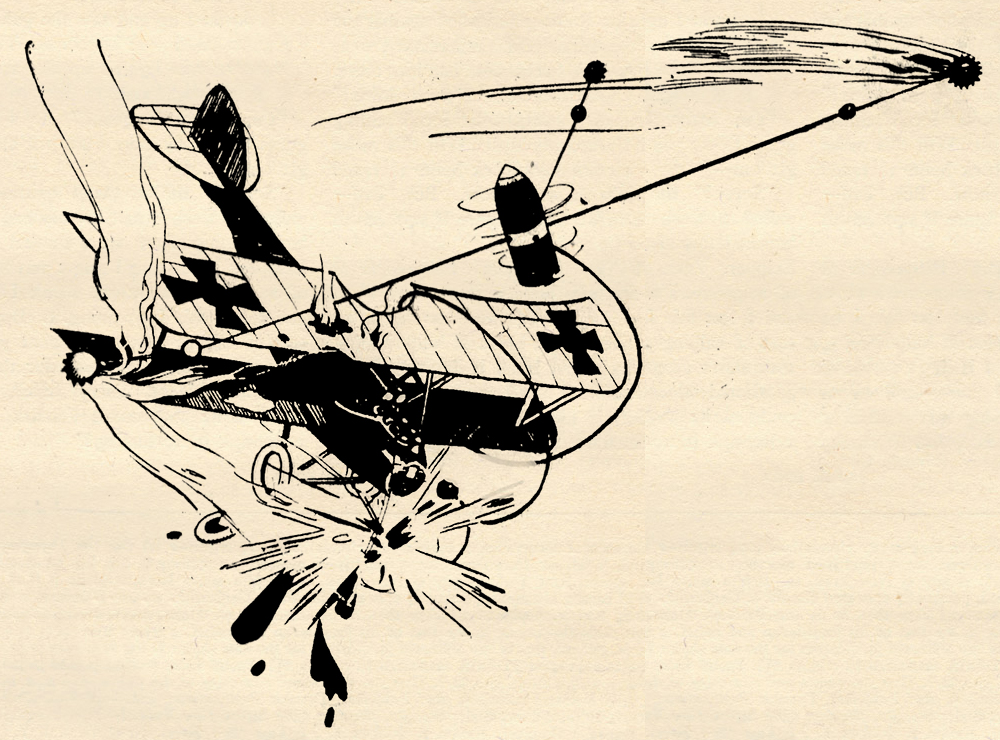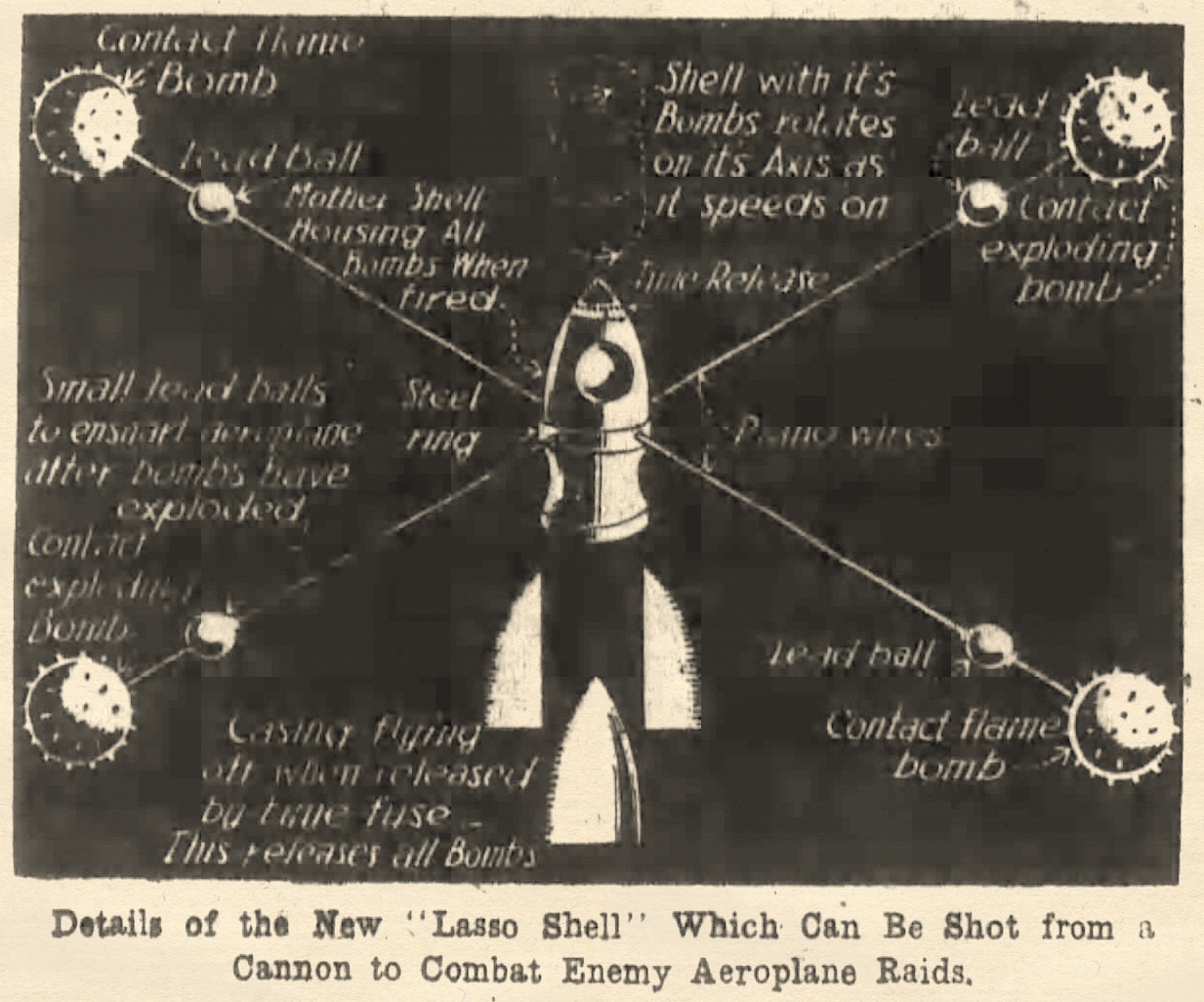Cowboys of the Air
HERE’S and interesting article from the pages of the San Francisco Chronicle in 1918 theorizing about a new “Lasso” bomb that would “rope” an enemy when exploded near their plane. Sounds like the kind of thing that should come from the pages of Robert J. Hogan’s six-gun ace, Smoke Wade, but is actually from the father of Science-Fiction himself, Hugo Gernsback, and The Electrical Experimenter!
“Cowboys” of the Air
The San Francisco Chronicle, San Francisco, California • 22 September 1918
How The New Lasso Shell Makes Possible the Rare and Exciting Sport of Roping Hostile Airplanes

“ARCHIES,” as anti-aircraft guns are called, throughout the war have been blazing away at Hun airplanes and scoring some remarkable hits. However, military experts are of the opinion that it is impossible to stop an aerial raid by means of anti-aircraft guns alone. Notwithstanding the fact that the armed aeroplane Itself is probably the most effective means of downing enemy planes, there is a long felt want of some other method of clearing the skies of raiders.
With this idea in mind Mr. H. Gernsbeck, editor of the Electrical Experimenter, has perfected a plan which he says, to a certain degree, will accomplish such a result. The principle of this writer’s device, which is illustrated and described in the Electrical Experimenter, centres upon the “chain-shot,” which was nothing else but chaining several cannon balls together and shooting them at the enemy with devastating results. As the erratic flight of such a device made it extremely inefficient, it was soon given up and came into disuse.
“In my device,†says Mr. Gernsbeck, “I propose the use of a ‘mother-shell’ containing two explosive bombs, as well as two ’liquid-fire’ bombs. Each one of these bombs has a smaller companion—a heavy lead ball, the purpose of which is explained later.
“All of the bombs and bails are normally housed in the metal mother-shell which need not be very heavy, as it does not contain any explosive charge itself. All the bombs are kept in their respective places by means of a casing composed of eight pieces of reasonably thin steel. These pieces are released from the mother-shell, and fly off as soon as the time mechanism located at the apex of the mother-shell permits this. This time mechanism works on the principle of the one used on shrapnel, the purpose of the present device being to keep the mother-shell intact till it comes within a few hundred feet of the aeroplane under attack. This, of course, makes for great accuracy, as the mother-shell can be accurately timed, and being a self-contained shell like any other, its flight will naturally be true.
“The mother-shell In addition is ‘rifled,’ exactly like other big shells. A rifled shell while still in the cannon is made to turn on its axis by following a corkscrew path cut Into the inner walls of the cannon. This Imparts a spinning action to the shell which it maintains during its entire flight. So while the shell flies over its course with its nose pointed at its target, it also spins like a top. This spinning action, it has been found, keeps the shell better on its course than if it did not spin.
“In the case of the rifled mother-shell, another distinct advantage is had. Aside from keeping the shell on a true course as soon as the time mechanism acts, the pieces of the casing are thrown violently outward by centrifugal action. The same is the case of the four bombs which art hurled outwardly as shown in the illustration. Each set of bombs and balls are attached to a central steel ring by meant of a thin, but tremendously strong steel piano wire. Each wire may be from two hundred to three hundred feet long as desired. But as the mother-shell and the various bombs still have their rotary (spinning) motion, it follows that the entire device will continue to revolve not unlike a miniature planetary system. The four piano wires will be straight and taut, and as they cut the air at a great rate of speed, they will probably ’sing’ with a weird as well as a shrill note.
“We now have an aerial lasso covering a circular space of from four hundred to six hundred feet, all depending upon the length of the piano wires.
“Woe to the enemy aeroplane flying into it, or which is overtaken by it! There can be no escape. If either of the two contact-exploding bombs touch the aeroplane, it will be wrecked by the terrific ensuing explosion. If either of the contact-flame bombs touch, liquid fire kill be sprayed over wings or fuselage, setting the plane on fire.

“But let us suppose that neither type of bomb were effective, or touched only non-vltal parts of the enemy plane. Here it is where the lead balls take up their deadly work. Suppose all the four bombs bad been exploded. If it were not for the four lead balls, the four piano wires would simply go limp and the fight would be over. But having these lead balls spaced about ten feet from the explosive bombs, they will not be affected at all after the former have been set off.
“The planetary system, broadly speaking, still remains intact, although now we have only four ‘moons’ left. But suppose only one of them manages to get entangled in the trusswork of the enemy plane. Immediately the flight of the entire system is stopped abruptly and the three other balls come whining around, snarling up the entire plane and breaking the wings, fuselage or tail as they come crashing down at a terrific speed.
“You have read of the terrible Mexican lasso, the Bolas, which is a lasso with lead balls. It works on the same principle as the aerial lasso, only the latter having lead balls weighing several pounds apiece, will cause correspondingly greater havoc, especially on a comparatively fragile aeroplane.
“Perhaps you have read accounts of aerial fliers and their dread to intercept the course of even the smallest bird. It is a well known fact that an aeroplane propeller revolving at its great speed, will be instantly shattered if a bird as small as a sparrow flies into it. Therefore it may be imagined what a large load ball, or a powerful piano wire will do to a propeller should either come in contact with it.”
- Download “Cowboys of the Air” (September 22, 1918, San Francisco Chronicle)
And look for Smoke Wade to return real soon in a new volume of rip-snortin’ air adventures!




